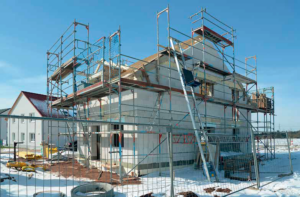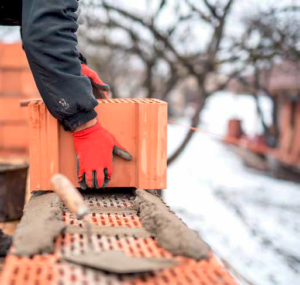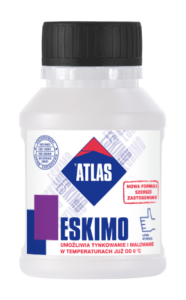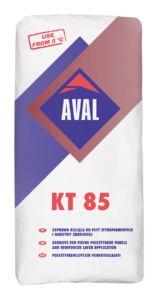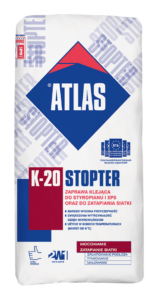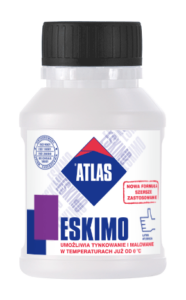- Products
- Systems
- Tools & Services
News
Which construction works can be carried out in the wintertime?
The construction works season varies and depends on a country and its climate. It is said that in Poland it lasts from the 15th of April till the 15th of October. However, in practice the season is determined by the atmospheric conditions. Thus, the most important question is: what construction works can be carried out in the wintertime at the reduced temperature?
Let’s start with the explanation of the concept of reduced temperature. According to the common definition, this term
means the conditions when the average air temperature during the day is lower than + 5°C, and the minimum temperature can drop below 0°C. Most building materials are used in temperature between +5°C and +25°C. This temperature range provides optimal conditions which allow us to use most of the materials – the setting processes binders are correct then. This in turn guarantees that the materials will reach appropriate resistance and operational parameters.
Thermal insulation works carried out in difficult conditions.
The appropriate temperature during the insulation works is extremely important due to very thin coats of the applied materials. The coat of adhesive for thermal insulation material can be up to 10 mm thick, mortar for the base coat is only 3-4 mm thick, and thin-coat render (depending on the aggregate used) even 1.5 mm.
Needless to say, low temperature can be very destructive for so thin layers. In the case of traditional cement plasters (usually 15 – 20 mm thick) the frost can cause “only” efflorescence and outer surface flaking off. In contrary, in case of thin-coat renders the coating can get completely frozen and damaged.
The use of additives analogous to those added to concrete or thick cement mortars, which allow us to work at low temperature, would not be the right approach here. The only solution regarding the insulation works here is to choose mortars of customized recipe designed for use in conditions that can occur during light winter.
Mortar for winter conditions
Cement adhesive mortar Atlas Stopter K-20 (Aval KT 85) is a product:
– for use both to bond polystyrene boards and to form basecoat layer,
– very universal – can be used in the temperature range: from 0°C up to +25°C. What is more, the temperature drop down to -5° C after 8 hours since the mortar application does not provide any damage to the applied adhesive coat.
Render under threat
Having applied the insulation material and carried out the basecoat, one can begin rendering (after priming the substrate). In this case, the external conditions also play an important role (render is applied not only due to its technical function, but also decorative one). Frost, even if it does not destroy unset thin-coat render, it can cause white efflorescence or discoloration on its surface.
How to avoid this?
– 1st solution: we can stop the insulation works when the basecoat is applied. We should also remember that the basecoat should not be left without any additional protection for the winter period. In such situations, it is recommended to use the priming mass for renders which forms a coating which protects the basecoat against adverse atmospheric factors and, above all, makes the surface hydrophobic. We recommend using ATLAS Cerplast (Aval KT 16) for this purpose, provided that the finish is to be a mineral, acrylic or acrylic-silicone render. In the case of silicone and silicone-silicate renders one should use ATLAS Silkon ANX.
– 2nd solution: we can use a dispersive render which composition can be modified with appropriate chemical additives in order to speed up the process of setting. It happens that the interruption of application is impossible, for example because of the growing costs of scaffolding rental or tight schedules of contractors.
Why to use a dispersion render, not the cement render? Its composition can be easily modified and the process of setting can be significantly accelerated with the aid of aforementioned additives. ATLAS Eskimo performs superbly here. It is added to render or paint mass immediately before their use. It accelerates the first stage of the process of setting of the dispersive products – water evaporation from the applied material. Therefore, the material gets resistance to sudden cooling or rainfall faster (only after 6-8 hours).
|
|
We recommend: ATLAS Eskimo – setting accelerator for renders and paints – enables rendering and painting in temperature 0°C – 10°C (render sets too quickly if used in higher temperature) and in high humidity (above 80%), – easy in use – dosed directly to material before application upon a façade, – accelerates the setting of a coating, – neutral to other properties of materials, – provides early resistance to rain, – dosing: 0.25 kg per 25 kg of render, 0.15 kg per 10 l of paint.
Add ATLAS Eskimo in winter! Materials which can be modified with ATLAS Eskimo setting accelerator: – ATLAS Atlas-Silicone Render |
Surface protection
To protect fresh render or paint coating from sudden change of atmospheric conditions (rain, strong sunlight) there must always be the scaffolding protection used. Most often these are protective nets which protect the fresh render against exposure to sunlight, rain and dirt carried by the wind only. One can often see tarpaulins and provisional tents made of construction film. It happens that contractors use heaters placed on scaffolding, secured with foil or tarpaulins. The heaters are used to increase the temperature. As beneficial can it be for the employees, it has definitely adverse effect on freshly applied renders or paints. It is related to the risk of excessive surface drying – in other words render can get dry before it sets. Higher temperature under the foil or tarpaulin (in comparison to the ambient temperature) can
also lead to water condensation on their surfaces and higher humidity. As the dispersion renders set, also by
evaporation of water, high humidity definitely slows down the process.
|
Water resistance vs. frost resistance WATER RESISTANCE feature characterizes the material which is resistant to water. It means that the material does not lose its technical parameters (especially bonding and strength) under the influence of water. It should be added that this applies to permanent moisture action as well. FROST RESISTANCE is very closely related to water resistance and it means that the material is resistant for altering freeze-thaw cycles, related to the temperature change. ATTENTION: both terms refer to material parameters when it is set and hardened. The situation looks completely different in case of freshly used material, which has not yet obtained assumed technical parameters. |
Bricklaying and concrete application without problems
It is said that the worst time for freezing in case of concrete is the period of time between the beginning of setting process and the moment when concrete reaches critical strength. It is required that the concrete has at least 5 MPa compression strength on the surface when it is exposed to freezing (EN 1370 standard).
Temperature influence
– Temperature from +1°C to +10°C does not have any adverse effect on concrete. It neither damages nor reduces the quality. However, it makes the cement setting and mortar hardening processes slower. Concrete in such conditions do not achieve the designed compressive strength in the time determined by the standard – 28 days.
– Temperature lower than 0°C has harmful impact on “fresh concrete”. Micro destruction in the structure of hardening concrete takes place at so called critical temperature (from -1°C to -5°C) – when about 50% of water freezes.
During freezing, water in the concrete pores increases the volume by about 10%. It causes stress inside the concrete which can result in cracking. The destruction process depends on the amount of water. Damage is more severe in case of cyclic freezing and thawing.
Harmful freezing
Freezing water causes damage because:
– forms crystals which, after melting, leave voids which lower the concrete strength,
– increases the volume by about 10%, which can lead to cracks and scratches in the result of stress exceeding fresh concrete resistance,
– cannot take part in the hydration process of cement.
There are a number of ways to keep the concrete temperature at the appropriate level, e.g. dosing warm mixing water, heating and using special additives – admixtures.
Special additive
The admixtures are commonly called the “counter-frost” (in the current systematic structure introduced by EN 934-2 standard they are not defined). They are available in the form of liquids or powders intended to modify the properties of building materials immediately before their use, applied at the construction site. These special admixtures are able: to reduce the freezing point of mixing water added to fresh concrete, reduce the amount of mixing water while keeping the consistency, accelerate release of cement hydration heat, increase the concrete temperature.
Original text: Sebastian Czernik, ATLAS Group
English text: Piotr Marciniak, ATLAS Group
